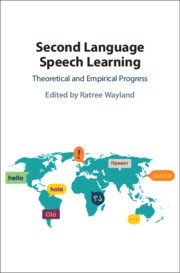Book contents
- Second Language Speech Learning
- Second Language Speech Learning
- Copyright page
- Dedication
- Contents
- Figures
- Tables
- Contributors
- Preface
- Acknowledgments
- Part I Theoretical Progress
- Chapter 1 The Revised Speech Learning Model (SLM-r)
- Chapter 2 The Revised Speech Learning Model (SLM-r) Applied
- Chapter 3 New Methods for Second Language (L2) Speech Research
- Chapter 4 Phonetic and Phonological Influences on the Discrimination of Non-native Phones
- Chapter 5 The Past, Present, and Future of Lexical Stress in Second Language Speech Production and Perception
- Part II Segmental Acquisition
- Part III Acquiring Suprasegmental Features
- Part IV Accentedness and Acoustic Features
- Part V Cognitive and Psychological Variables
- Index
- References
Chapter 2 - The Revised Speech Learning Model (SLM-r) Applied
from Part I - Theoretical Progress
Published online by Cambridge University Press: 21 January 2021
- Second Language Speech Learning
- Second Language Speech Learning
- Copyright page
- Dedication
- Contents
- Figures
- Tables
- Contributors
- Preface
- Acknowledgments
- Part I Theoretical Progress
- Chapter 1 The Revised Speech Learning Model (SLM-r)
- Chapter 2 The Revised Speech Learning Model (SLM-r) Applied
- Chapter 3 New Methods for Second Language (L2) Speech Research
- Chapter 4 Phonetic and Phonological Influences on the Discrimination of Non-native Phones
- Chapter 5 The Past, Present, and Future of Lexical Stress in Second Language Speech Production and Perception
- Part II Segmental Acquisition
- Part III Acquiring Suprasegmental Features
- Part IV Accentedness and Acoustic Features
- Part V Cognitive and Psychological Variables
- Index
- References
Summary
This chapter reviews research examining the acquisition of English /r/ and /l/ by native Japanese (NJ) speakers from the perspective of the revised Speech Learning Model. The research shows that the English liquids can be learned after the end of the so-called “critical period” for speech learning, but that the two liquids are learned in different ways. This derives from the fact that the English /r/ is perceived to be more dissimilar phonetically from the Japanese liquid, /R/, than English /l/ is. NJ speakers who have received a substantial amount of English input produced and perceived English /r/ with high levels of accuracy due to the formation of a new phonetic category for English /r/. The lower level of accuracy observed for English /l/ is attributed to the formation of a composite Japanese /R/-English /l/ category based on the Japanese /R/ and English /l/ productions to which Japanese-English bilinguals have been exposed. The SLM-r predicts that bilinguals will continue to produce and perceive English /l/ less accurately than English /r/, regardless of how much English input they have received, and that learning the English liquids will induce modifications in how NJ speakers will produce and perceive their native /R/.
- Type
- Chapter
- Information
- Second Language Speech LearningTheoretical and Empirical Progress, pp. 84 - 118Publisher: Cambridge University PressPrint publication year: 2021
References
- 11
- Cited by



